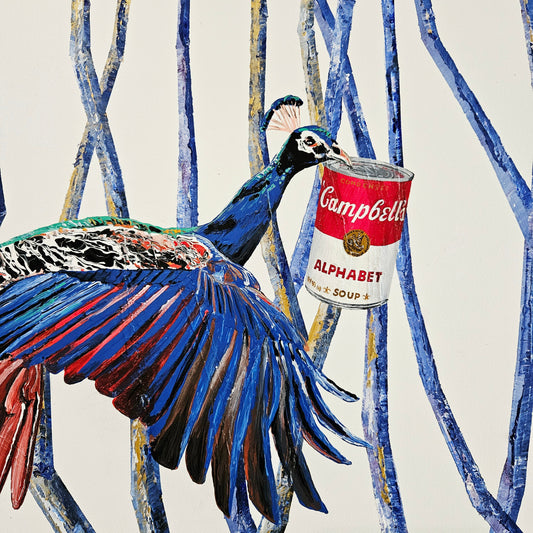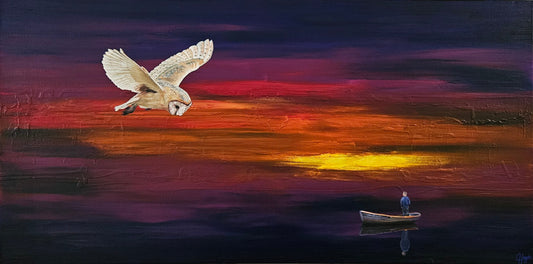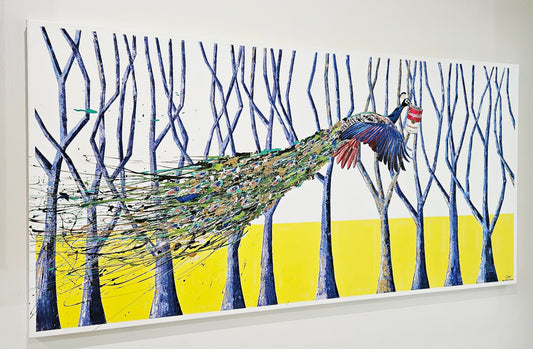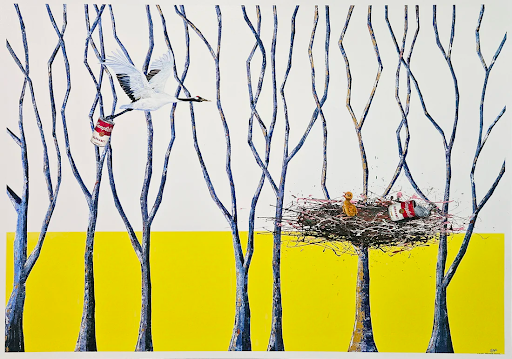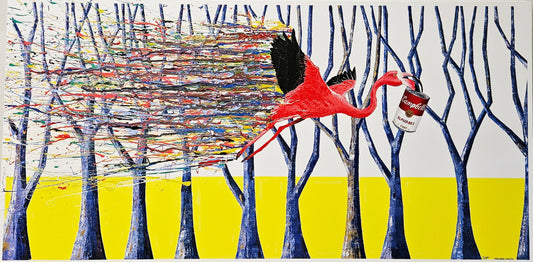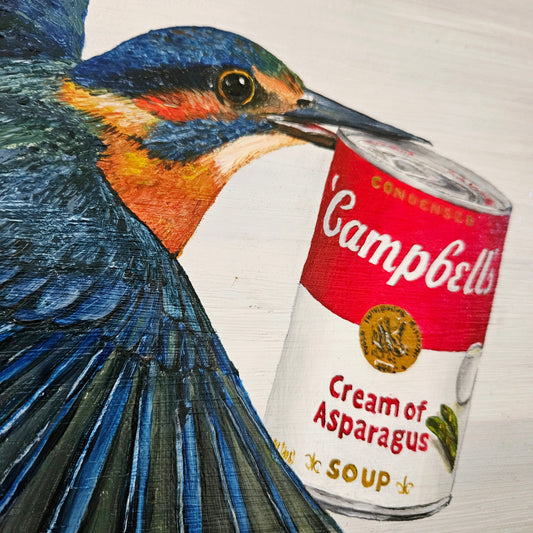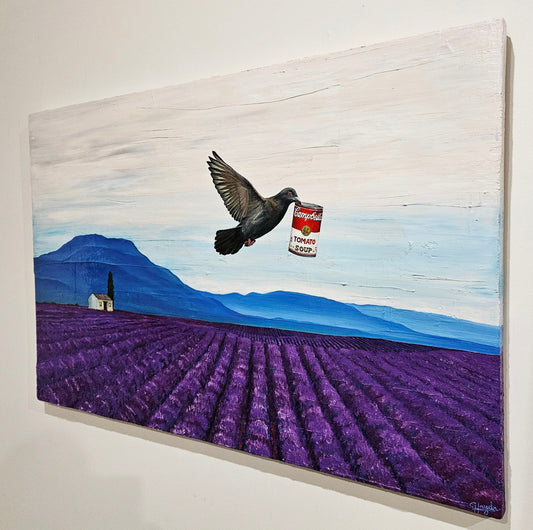New York City Butterflies: Where Monarchs Meet the Metropolis

New York City Butterflies – Exploring the Symbolism of Monarchs in an Urban Landscape
In New York City Butterflies, artist Haydn captures a unique interplay between the organic and the constructed, blending the elegance of monarch butterflies with the sharp, angular forms of an urban skyline. The painting presents a moment of quiet poetry, three monarchs in motion, drifting across a space where architecture meets nature, where flight navigates between steel and sky.
What stands out immediately is the juxtaposition. The butterflies, rendered with the characteristic orange and black patterns of monarch wings, carry delicate outlines of New York City’s skyline within their forms. Skyscrapers stretch within their wings like bone structures, their shapes seamlessly integrated into the butterfly’s anatomy. Haydn does more than create a visual hybrid. In doing so, he presents a metaphor.
It’s a reflection on adaptation, on the blending of the natural world with human design. The monarch, a creature associated with fragility and flight, takes on a new resilience in this urban context. Yet, it doesn’t lose its grace. The wispy and impressionistic trees in the background frame the butterflies without overshadowing them, suggesting a liminal space, possibly a park at dawn or a quiet avenue softened by movement and air.
There’s a quietness to this painting, a sense of stillness despite the motion. The butterflies seem almost suspended in time, mid-flight, not entirely departing and not quite arriving. This ambiguity is echoed in the setting. There’s no hard line between the city and the natural world. Instead, the two seem to merge, as if each butterfly is carrying part of the city, perhaps in memory or resistance.
Around the world, the monarch butterfly is steeped in meaning. In many cultures, it symbolises transformation, endurance, and life cycles. Its migration, particularly across North America, is considered one of the most extraordinary phenomena in the natural world. Monarchs travel thousands of kilometres across countries and borders, guided not by maps or logic but by instinct and ancestral memory.
In Mexican culture, the monarch’s annual return coincides with Día de los Muertos, the Day of the Dead, and is thought to carry the souls of the departed. This connection to remembrance and return gives the butterfly an added spiritual dimension. In some Native American traditions, butterflies are considered carriers of dreams and prayers. In other belief systems, they are signs of hope and renewal, delicate messengers reminding us of impermanence and the beauty of change.
Replacing the monarch in New York City means reframing that symbolism in a new context. It becomes a story of survival, of finding space for softness and movement in one of the world’s most rigid, fast-paced environments. The butterfly becomes a traveller and an inhabitant, claiming a place in the landscape of buildings and shadows.
This is what makes New York City Butterflies so quietly compelling. It does not romanticise nature or the city but asks what happens when the two intersect. It considers how nature adapts and embeds itself even in most human spaces. It asks us to notice these moments: the flash of wings above a subway grate, the rustle of leaves against a skyline, and how life insists on moving, even in concrete.
The painting does not tell a fixed story. Instead, it offers an image open to interpretation. For some, it may evoke a sense of nostalgia—a longing for balance in a chaotic world. For others, it may suggest resilience, the quiet determination of the natural world to coexist with urban progress. It might be read as a commentary on fragility or endurance.
Haydn’s technique supports this open-endedness. His brushwork in the background is soft and tonal, shifting between greys and muted colours, while the butterflies are painted with clarity and precision. They feel like momentarily landed in the city’s breath—part of it, and somehow above it.
In a time when urban expansion continues to edge out natural spaces, New York City Butterflies offers a moment of reflection. It encourages the viewer to consider how nature persists, adapts, and finds moments of beauty in unlikely places.
The monarch, both fragile and strong, symbolises that persistence. The city, often cast as its opposite, becomes part of its story. The result is a painting that lingers not loud or demanding but quietly powerful, like the soft beat of wings over a busy street.
There’s also something inherently hopeful in the imagery. The monarchs don’t appear overwhelmed by the city they carry. They glide through it effortlessly. The skyline within their wings doesn’t weigh them down; it becomes part of their identity. This interplay can be seen as a metaphor for human experience in the urban world: even amidst pressure, structure, and constant motion, individuals can still move with grace, retain softness, and maintain their connection to nature and self.
The composition allows these ideas to breathe. The painting has ample negative space, which doesn’t crowd the butterflies but lets them drift. The background, with its misty tones and gentle transitions between colours, feels like air. It could be early morning or late evening, a liminal moment when the world is neither fully awake nor asleep. These are the times when subtle things like butterflies become more visible and profound.
One can also read this piece as a meditation on migration and identity. Monarch butterflies are renowned for their migratory patterns, with some populations travelling over 4,000 kilometres. They navigate vast distances across changing landscapes, guided not by sight but by a deep, internal knowing. The monarch's journey can hold layered meaning in an age where the migration of people, ideas, and cultures is both a reality and a point of global tension. It symbolises movement across boundaries, a quiet insistence on survival, and the beauty of crossing distances.
New York City itself is a place built on such movement. A global hub of people and stories, it contains countless backgrounds, transformations, and reinventions. In New York City Butterflies, Haydn brings this urban mythology into conversation with nature’s own rhythms, creating a space where the butterfly and the city coexist, share space, and even merge.
The painting's subtle emotional tone allows for a reflective experience. It doesn’t push a narrative or seek dramatic tension. Instead, it gently offers itself for contemplation. Viewers may be drawn in not just by the detail in the butterflies’ wings or the muted layers behind them but by what the painting quietly suggests: the presence of nature in even the most constructed environments, the flight paths we trace in our own lives, and how place and identity are inextricably linked.
Haydn’s ability to anchor these concepts in a single, still moment makes this painting feel so timeless. It is rooted in contemporary urban life and utterly detached from time. The butterflies could be yesterday, today, or decades from now, still flying, adapting, carrying the city on their wings.
Ultimately, New York City Butterflies doesn’t ask for answers. It poses gentle questions: What does moving through the world with lightness and resilience mean? How do we carry the places we come from within us, and how do they shape our journey? Where does nature end and the city begin—or do they end at all?
In this way, the painting becomes less about monarch butterflies or buildings and more about the quiet interweaving of stories, symbols, and spaces. It invites us to pause and consider the beauty in flight, the softness in structure, and the small but persistent miracles that occur above our heads every day—unnoticed by many but fully alive to those willing to look.

